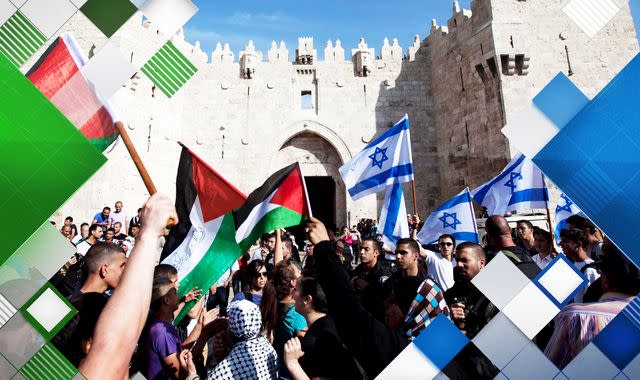What is the two-state solution for Israel and Palestinians?

The two-state solution has long been proposed as the best hope for peace in the Israel-Palestine conflict.
It would see an independent Palestinian state established alongside the existing one of Israel - giving both people their own territory.
It is the official position of the UK, US, United Nations - and even Israel itself - but many now say there is little hope of achieving it.
Here, we look at some of the key obstacles.
What would it look like - and who would live where?
The biggest obstacle to a two-state solution is deciding what the borders of a potential Palestinian state would be.
Many believe they should be the same ones that existed before the 1967 six-day war, which saw Israel occupy East Jerusalem, the West Bank and Gaza.
Since then, increasing numbers of Israeli settlements have been established inside the West Bank, with around 600,000 Israelis now living there and in Occupied East Jerusalem.
Although these settlements are considered illegal under international law, their existence makes the territory increasingly difficult to designate as Palestinian.
Read more:
The deep roots of the Israeli-Palestinian conflict
Satellite images show destroyed homes in Gaza
How did this war happen?
The creation of Israel and subsequent Arab-Israeli war of 1948 saw many Palestinians forced from their homes, in what is known as the Nakba, or "catastrophe" in English.
As such, the UN gave around 750,000 people refugee status, defined as people "whose normal place of residence was Palestine during the period 1 June 1946 to 15 May 1948, and who lost both home and means of livelihood as a result of the 1948 conflict".
But under the same criteria, 5.9 million Palestinians - who live in the West Bank, Gaza, East Jerusalem and in camps across Jordan, Lebanon and Syria - now qualify, and many would want to return to their homeland.
There would not be space for this increased number of people inside the occupied territories, meaning some would have to be resettled in Israeli territory, which goes against Israel's idea of a two-state solution.
Jerusalem
There are particular border difficulties with Jerusalem.
Both sides claim the ancient city as their capital. This is because of its huge historical and religious significance for both Israelis and Palestinians and the fact it is home to several holy sites in Judaism, Islam and Christianity.
For example, the walled Old City hosts both The Temple Mount - Judaism's holiest site - and Al Aqsa Mosque, the third most important location in Islam behind Mecca and Medina, where Muslims believe the Prophet Muhammad ascended to heaven.
Earlier this year, there were violent clashes between Israeli police and Palestinian worshippers there.
The Israeli government claims Jerusalem is their "undivided capital", and it is the seat of the Israeli government and parliament (Knesset), but East Jerusalem is widely considered an occupied Palestinian territory.
In theory, a two-state solution would officially recognise both East Jerusalem as the Palestinian capital and a western part of the city for the Israelis.
Who supports it - and what are their conditions?
Israel's official position endorses a two-state solution, but on the condition the Palestinian side demilitarises - as it sees Hamas and other militant groups, as an existential threat.
Fatah and the governing Palestinian Authority in the West Bank support the solution, providing they are allowed to police themselves.
Hamas, which controls Gaza, has committed itself to the destruction of Israel. However, in a revised charter published in 2017, it said it would accept a Palestinian state along the 1967 borders.
The lack of consensus on the Palestinian side makes the solution difficult - and an increasing number of Israeli politicians now reject the idea too.
Indeed, Israel's current president, Benjamin Netanyahu, was quoted by the country's national broadcaster in June as saying Palestinian hopes of a sovereign state "must be eliminated".
Although the UN and international community have widely condemned the expansion of Israeli settlements in the West Bank and consider them a major barrier to peace - little has been done to deter Israel.
Israel disagrees and cites historical and biblical ties to the land.
Israel is widely considered to hold a power advantage over the Palestinians, economically and in terms of its military resources.
It has benefited from the strong and consistent support of the United States, from which it has been the largest cumulative recipient of US foreign aid since the Second World War.
Why have some lost hope?
Hope for the two-state solution peaked in the early 1990s, when the US facilitated the signing of the Oslo Accords under the presidency of Bill Clinton.
Famously, then Israeli prime minister Yitzhak Rabin and Palestinian Liberation Organisation chairman Yasser Arafat shook hands on the lawn of the White House.
The Oslo Accords saw Israel formally acknowledge the PLO as representative of the Palestinians, and in return the group renounced violence.
The two sides agreed on the formation of a Palestinian Authority, which would govern the West Bank and Gaza for a five-year period.
Mr Rabin was assassinated by a young Jewish nationalist two years later - which many argue saw hopes of the two-state solution diminish.
Since then, various factors have further reduced the chances of the two sides agreeing on a peaceful resolution.
These include: increased Jewish settlements in the West Bank; Donald Trump's presidency and his relocation of the US embassy from Tel Aviv to Jerusalem; the most right-wing Israeli government in the country's history; and this month's Hamas attack and the ensuing war.


